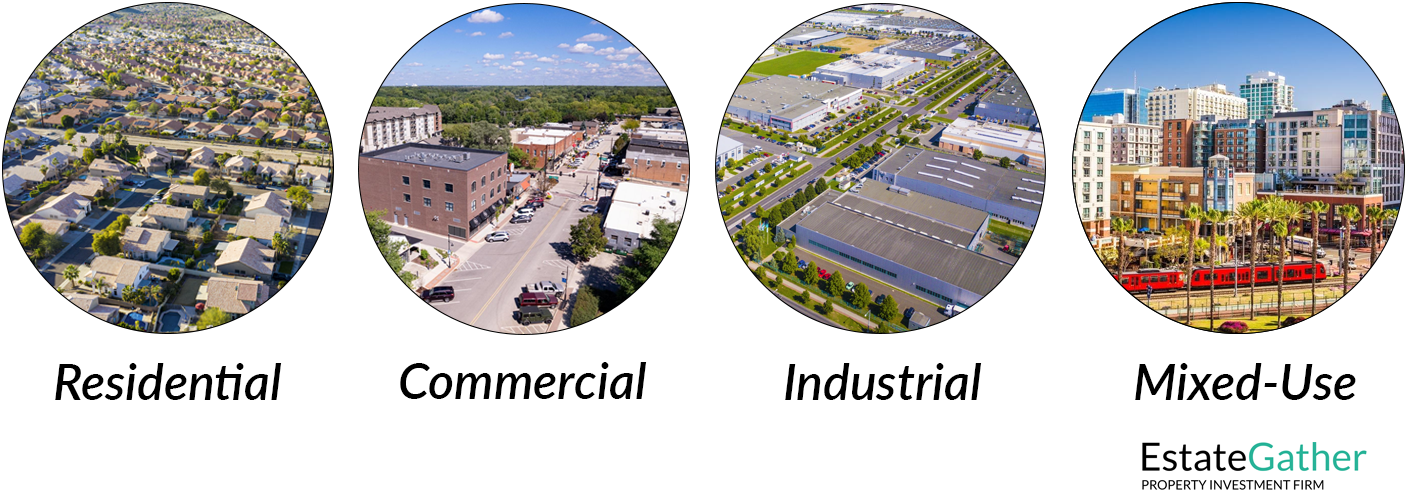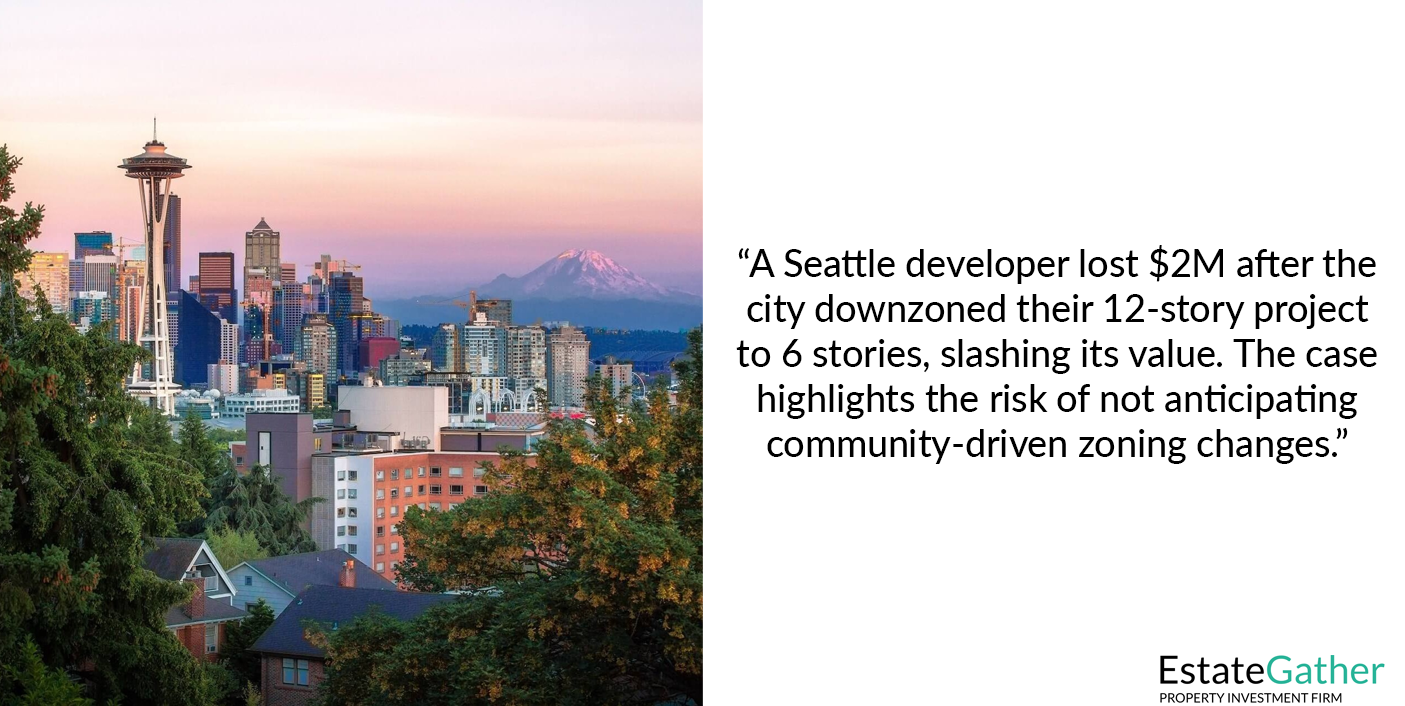Zoning Laws
Zoning laws are a fundamental aspect of real estate investment that can significantly influence property values, development potential, and the overall success of an investment. These regulations, which dictate how land can be used in different areas, play a critical role in shaping the character of neighborhoods and cities. For investors, understanding zoning laws is essential for making informed decisions, identifying opportunities, and navigating potential challenges.
KEY TAKEAWAYS
- Zoning Laws Shape Property Value and Development Potential: Zoning regulations dictate how land can be used, directly impacting property value and development opportunities. Investors must understand a property’s zoning classification to ensure their intended use is permitted and to assess the property’s true investment potential.
- Zoning Changes Create Opportunities and Challenges: Changes in zoning laws, such as upzoning or downzoning, can significantly alter a property’s value and allowable uses. Staying informed about potential zoning changes and participating in local planning processes can help investors capitalize on opportunities and mitigate risks.
- Thorough Research and Expert Consultation Are Essential: To navigate the complexities of zoning laws, investors should conduct thorough research, consult with zoning experts, and stay engaged with local zoning authorities. This strategic approach can help investors maximize returns and avoid legal pitfalls in their real estate investments.
What Are Zoning Laws?
Zoning laws are regulations established by local governments that define how land within specific geographic areas can be used. These laws determine what types of buildings and activities are permitted in certain zones, such as residential, commercial, industrial, or mixed-use areas. Zoning laws are designed to ensure that land is used in a way that promotes the health, safety, and general welfare of the community.
Zoning classifications typically fall into the following categories:
- Residential Zoning: This category includes areas designated for single-family homes, multi-family apartments, townhouses, and other types of residential dwellings. Residential zoning laws often specify the types of housing allowed, minimum lot sizes, building heights, and setback requirements. In most places, residential zoning typically means one to four units.
- Commercial Zoning: Areas zoned for commercial use are intended for businesses such as retail stores, restaurants, offices, and other commercial enterprises. Commercial zoning laws regulate factors such as building size, parking requirements, signage, and the types of businesses that can operate in the area. Commercial zoning also refers to multi-family apartments with more than four units. Commercial multifamily has different loans, different property rules, stricter underwriting, and often higher insurance than small multifamily.
- Industrial Zoning: Industrial zones are designated for manufacturing, warehousing, and other industrial activities. These areas are typically located away from residential neighborhoods to minimize the impact of noise, traffic, and pollution. Industrial zoning laws govern aspects like building heights, emissions, and access to transportation infrastructure.
- Mixed-Use Zoning: Mixed-use zones allow for a combination of residential, commercial, and sometimes industrial uses within the same area. These zones are often used in urban areas to promote walkability, reduce the need for transportation, and create vibrant, multi-functional neighborhoods.
Four Zoning Categories

Zoning Variations Across U.S. Cities
It’s important to recognize that zoning codes can vary widely across different cities and municipalities in the United States. While general zoning categories like residential, commercial, industrial, and mixed-use exist across the country, each city has its own unique approach to land use planning. These local variations are based on community needs, geographic constraints, economic goals, and local political factors. For investors, this means that understanding the zoning codes of a specific city is essential, as what is allowed in one city might be prohibited or heavily regulated in another.
For example, some cities may have strict height limits or density restrictions in residential zones, while others may encourage higher density development to address housing shortages. Similarly, commercial zoning regulations may differ in terms of parking requirements, building setbacks, or signage restrictions. In more environmentally conscious cities, there might be additional overlays that enforce green building standards or protect historic districts.
This variation in zoning codes presents both opportunities and challenges for real estate investors. Those who take the time to understand how local zoning works in a specific market can uncover hidden opportunities, such as properties that are primed for rezoning or areas likely to benefit from upcoming zoning changes. On the other hand, investors who neglect to consider local zoning nuances may encounter costly setbacks or limitations on their development plans.
Sponsor
YOUR
ADVERTISEMENT
HERE
Just $20 a Month, for full site coverage.

How Zoning Laws Affect Property Investment
Zoning laws have a direct impact on the value and potential of a property. For investors, these regulations can create opportunities or present challenges depending on how they align with investment goals.
Influence on Property Value
Zoning laws can significantly affect the market value of a property. For example, a parcel of land zoned for high-density residential development may be more valuable than one zoned for single-family homes due to the potential for greater revenue from multiple units. Similarly, a property in a commercial zone may command a higher price if it’s located in a desirable business district.
Development Potential
The type of zoning on a property determines what can be built and how it can be used. Investors must understand the specific zoning regulations of a property before purchasing to ensure their intended use is permitted. For example, if an investor plans to develop a mixed-use building with residential units above ground-floor retail space, they must confirm that the property is zoned for mixed-use development. Failure to do so could result in costly delays, additional permitting requirements, or even the inability to move forward with the project.
Impact on Financing and Insurance
Zoning laws can also affect the availability and cost of financing and insurance for a property. Lenders and insurers often consider the zoning classification when assessing risk and determining terms. Properties in industrial zones, for example, may face higher insurance premiums due to the increased risk of environmental hazards, while properties in commercial zones might offer more favorable financing terms if they are located in a thriving business area.
Compliance and Legal Challenges
Investors must comply with zoning laws to avoid legal issues that can arise from non-compliance. Violating zoning regulations can result in fines, legal disputes, and the need to modify or even demolish structures that do not conform to zoning requirements. Therefore, it’s important to conduct thorough due diligence and consult with zoning experts or legal professionals before making significant investments.
Opportunities and Challenges from Zoning Changes
Zoning laws are not static; they can change over time due to shifts in economic conditions, community needs, or government policies. These changes can create both opportunities and challenges for investors.
Opportunities from Upzoning
Upzoning occurs when a property’s zoning classification is changed to allow for more intensive use, such as increasing the allowable building height or density. Upzoning can significantly enhance a property’s value by enabling more lucrative development options. For example, a single-family home lot that is upzoned to allow for multi-family development can become much more valuable due to the potential for increased rental income or higher sales prices.
Investors who stay informed about potential zoning changes and engage with local planning processes can position themselves to capitalize on upzoning opportunities. This might involve purchasing properties in areas where upzoning is being considered or advocating for zoning changes that would benefit their investments.
Challenges from Downzoning
Downzoning, on the other hand, reduces the intensity of allowable use for a property. For example, a property previously zoned for high-density residential use might be downzoned to limit development to single-family homes. Downzoning can decrease a property’s value by restricting its development potential and limiting the ways it can be used.
Investors who own properties that are downzoned may face significant challenges, including reduced revenue potential and difficulty in securing financing. It’s important to stay engaged with local zoning authorities and participate in public hearings to advocate against downzoning that could negatively impact your investments.
Navigating Rezoning Processes
In some cases, investors may seek to have a property rezoned to align with their investment goals. The rezoning process typically involves submitting a proposal to the local zoning authority, participating in public hearings, and addressing any concerns from the community or government officials. Successful rezoning can unlock significant value in a property, but it requires a thorough understanding of the process, strong community relations, and sometimes legal or political expertise.
Sponsor
YOUR
ADVERTISEMENT
HERE
Just $20 a Month, for full site coverage.

Technological Tools for Zoning Research
Zoning regulations are complex and can vary significantly across municipalities, which makes thorough research essential for real estate investors. Fortunately, modern technology has made it easier to navigate zoning laws and find crucial information. These tools range from simple online maps provided by municipalities to sophisticated Geographic Information System (GIS) software, and they enable investors to research zoning, understand potential changes, and identify opportunities or challenges in a given area.
Here are several key technological tools investors can use for zoning research:
1. Municipal Zoning Maps and Portals
Many cities and towns offer online zoning maps and portals that provide direct access to zoning classifications and regulations for specific parcels of land. These tools are often provided for free and are maintained by local planning or zoning departments. They are typically updated regularly to reflect current zoning laws, and they often include features that allow users to explore zoning overlays, historic districts, and future land-use plans.
Examples of Municipal Zoning Maps:
- New York City Zoning and Land Use Map (ZoLa): This is an interactive tool provided by the NYC Department of City Planning. It allows users to view zoning districts, landmarks, building classifications, and other important land-use information. Investors can explore specific parcels by address, block, or lot number.
- San Francisco Planning Zoning Map: San Francisco’s zoning map provides information about zoning districts, height limits, and special use districts. Investors can use this tool to explore development opportunities or potential restrictions on a particular parcel.
- Los Angeles ZIMAS (Zone Information and Map Access System): ZIMAS provides detailed information about zoning, parcel numbers, land use, and special designations for properties within Los Angeles. This tool is particularly useful for investors looking to understand overlays such as historic districts, special planning areas, or green building requirements.
They often include information on upcoming zoning changes, overlay districts, or other factors that might impact property values.
These portals give investors an initial understanding of how a property can be developed based on current zoning rules.
They provide quick access to zoning classifications, helping investors determine if their intended use for a property (e.g., multi-family, commercial, mixed-use) is permissible.
2. GIS Mapping Software
Geographic Information Systems (GIS) are advanced tools that allow investors to view and analyze zoning data in conjunction with other important factors, such as demographics, infrastructure, environmental features, and transportation access. These tools can be used to create detailed maps that help investors visualize potential opportunities and risks.
Popular GIS Tools for Zoning Research:
- ArcGIS by Esri: ArcGIS is a professional-level tool widely used in real estate for mapping and analyzing spatial data. It allows users to overlay zoning data with other layers such as property boundaries, transportation networks, and population density. Investors can use ArcGIS to identify trends in urban development, assess land-use compatibility, and evaluate potential zoning changes.
- QGIS: QGIS is a free, open-source GIS software that provides many of the same features as ArcGIS. Investors can download zoning data from municipal databases and use QGIS to create custom maps that show zoning patterns, nearby amenities, and infrastructure.
- Google Earth with Zoning Overlays: Google Earth is another tool that can be enhanced with zoning data overlays. While less robust than ArcGIS, it allows users to view properties in a 3D environment and better understand the surrounding context. Zoning overlays can be imported to visualize restrictions and potential uses.
GIS software enables investors to see the “big picture” by overlaying multiple data layers, which can reveal relationships between zoning and other factors like traffic patterns, environmental concerns, or population density.
Investors can use GIS to identify undervalued properties with zoning classifications that permit higher-density development, or to spot areas where zoning changes are likely.
GIS mapping tools can help investors assess how future infrastructure projects (e.g., new transit lines) might affect zoning and property values in the long term.
Several online databases provide access to zoning information across multiple municipalities, making them a valuable resource for investors operating in different markets. These platforms consolidate local zoning codes, make them searchable, and often offer additional tools for real estate analysis.
3. Popular Online Zoning Databases:
- Regrid: This platform offers a nationwide parcel data map that includes zoning information, ownership details, and land-use data. Investors can search for properties by location, view zoning classifications, and analyze land-use patterns to identify potential investment opportunities.
- ParcelQuest: While ParcelQuest primarily focuses on parcel data for California, it includes detailed zoning information, property tax data, and legal descriptions. This tool is particularly helpful for investors looking to analyze large areas of land for potential development projects.
Online zoning databases centralize information, saving investors time by eliminating the need to navigate multiple municipal websites.
Investors can search for zoning classifications across different markets, enabling them to compare how different municipalities regulate land use.
Some of these platforms provide advanced search features, allowing users to filter properties by zoning type, proximity to amenities, or potential for rezoning.
4. Zoning Change Monitoring and Rezoning Tools
Investors often benefit from staying informed about zoning changes, especially in high-growth areas where rezoning may open up new opportunities. Certain tools and services allow investors to track zoning changes or file for rezoning themselves.
Zoning Change Monitoring Tools:
- ZoningHub: ZoningHub provides a user-friendly platform that enables local governments to post updates on zoning changes, public hearings, and upcoming rezoning proposals. Investors can subscribe to updates from specific municipalities to stay informed about potential zoning changes in their areas of interest.
- Municode: Municode provides access to municipal codes, including zoning ordinances, across the U.S. Investors can search and track zoning code changes, and Municode offers regular updates when new laws are passed.
Rezoning Application Tools:
- CommunityViz: This tool offers advanced zoning analysis and scenario planning for municipalities and developers. Investors can use it to explore the likelihood of a successful rezoning application by analyzing local planning policies and development trends.
Tracking zoning changes gives investors an edge in identifying areas where property values may rise due to favorable zoning amendments.
These tools help investors engage in the rezoning process by guiding them through legal requirements and offering expert insights into local zoning politics.
They enable investors to take proactive steps, such as purchasing land in areas poised for upzoning or advocating for zoning changes that align with their investment goals.
5. Public Records and Planning Department Portals
Municipal planning and zoning departments often maintain public records related to zoning amendments, variances, and development proposals. Investors can access these records to gain insights into ongoing zoning discussions and upcoming projects.
Examples of Public Record Portals:
- Chicago Department of Planning and Development: This portal allows users to view records related to zoning variances, special use permits, and development applications in Chicago. Investors can track projects that may indicate future zoning changes or shifts in neighborhood development patterns.
- San Diego Planning Commission Records: San Diego provides public access to records of all zoning hearings, variance requests, and development plans. This portal can be useful for tracking the city’s approach to growth and identifying areas where zoning flexibility is being considered.
Investors can track upcoming development projects, gaining insights into potential shifts in zoning policy or infrastructure investments that could affect nearby properties.
Accessing public records helps investors understand the local political climate surrounding zoning and development, which can be crucial for anticipating future changes.
These portals provide transparency about variances and zoning amendments, allowing investors to assess how flexible a city may be in granting zoning exceptions.
Specific Case Studies of Zoning Impact
Real-world examples can offer a clearer picture of how zoning laws and changes can directly influence property investments. These case studies illustrate both the opportunities and risks associated with zoning changes and demonstrate how investors can profit—or face challenges—depending on their understanding of local zoning regulations.
Case Study 1: Upzoning in San Francisco
In San Francisco, an investor purchased a single-family home in a neighborhood that was being discussed for potential upzoning. The city, facing a severe housing shortage, was actively seeking ways to increase density in certain areas to alleviate pressure on the housing market. The investor’s research revealed that city planners were contemplating a zoning change that would allow multi-family developments in the area.
Details of the Investment:
- Original Zoning: The property was zoned for single-family use, meaning only one unit could be constructed on the lot.
- Zoning Change: A proposed upzoning ordinance allowed the property to be reclassified as a higher-density residential zone, permitting the development of up to four units on the same parcel.
- Impact: Following the upzoning, the investor was able to secure permits to build a four-unit residential property. The increased density significantly enhanced the property’s value, as the new units could be rented or sold at market prices in a city with a high demand for housing.
Financial Outcome:
- Initial Purchase Price: $1.2 million (single-family home).
- Post-Zoning Change Valuation: $2.7 million, reflecting the new development potential.
- Total Profit: After construction costs, the investor netted over $1 million in profit, taking advantage of the upzoning to create more housing and dramatically increase the property’s value.

Key Takeaway: Investors who stay informed about potential zoning changes and engage with the city’s planning process can capitalize on upzoning opportunities. In this case, anticipating the upzoning and acquiring property early positioned the investor to reap significant rewards.
Case Study 2: Downzoning in Seattle
In contrast, a real estate developer in Seattle experienced a major setback due to a sudden downzoning initiative in the city. The developer purchased a parcel of land in an up-and-coming neighborhood with plans to build a high-rise residential building. The area was zoned for high-density residential use, allowing for a 12-story building, which aligned with the developer’s vision of creating luxury condos to meet the demand for urban living.
Details of the Investment:
- Original Zoning: The property was zoned for high-rise residential development, allowing for up to 12 stories.
- Zoning Change: Due to growing community concerns about the increasing density and congestion in the neighborhood, the city council voted to downzone the area, reducing the maximum building height to 6 stories.
- Impact: The downzoning effectively cut the planned development in half. With only six stories allowed, the revenue potential from the project was slashed, and the developer could not recoup the original financial projections.
Financial Outcome:
- Initial Purchase Price: $5 million for the land.
- Post-Zoning Change Valuation: $3 million, reflecting the reduced development potential.
- Total Loss: The developer faced a $2 million loss, as the project’s profit margins shrank dramatically due to the reduction in allowable units and the associated revenue.

Key Takeaway: Downzoning can significantly devalue a property by reducing its development potential. In this case, the developer failed to anticipate the community’s opposition to dense development and suffered a major financial loss as a result. Investors should monitor local sentiment and participate in zoning discussions to protect their interests.
Case Study 3: Rezoning Success in Houston
Houston’s lack of traditional zoning laws presents both opportunities and challenges for developers. In one case, a commercial real estate investor saw an opportunity to rezone a parcel of land located in an industrial district that was gradually transitioning into a mixed-use neighborhood. The investor purchased the property with the goal of rezoning it for residential use, taking advantage of the city’s more flexible approach to land use.
Details of the Investment:
- Original Zoning: The property was designated for light industrial use, limiting the types of developments that could be constructed.
- Rezoning Process: Recognizing the shift in neighborhood demographics and the demand for residential units, the investor petitioned the city to rezone the land for mixed-use development. The rezoning application included public hearings, community outreach, and coordination with local officials to address any concerns.
- Impact: After a successful rezoning, the property was reclassified as a mixed-use zone, allowing the investor to build a residential complex with ground-floor retail spaces.
Financial Outcome:
- Initial Purchase Price: $2 million for the industrial-zoned land.
- Post-Rezoning Valuation: $5.5 million, reflecting the new development potential and the increasing demand for residential units in the area.
- Total Profit: The investor realized a significant profit after selling the fully entitled land to a residential developer, more than doubling the initial investment.

Key Takeaway: Successful rezoning can unlock hidden value in underutilized properties. In this case, the investor’s foresight and proactive approach to working with local authorities transformed a low-value industrial property into a prime mixed-use development opportunity.
Case Study 4: Short-Term Rental Zoning Restrictions in Los Angeles
With the rise of platforms like Airbnb, short-term rental properties have become a popular investment strategy. However, zoning laws can dramatically impact the feasibility of short-term rentals. In Los Angeles, an investor who owned several properties planned to convert them into short-term rentals. Unbeknownst to the investor, the city was in the process of tightening regulations on short-term rentals, particularly in residential areas.
Details of the Investment:
- Original Zoning: The properties were located in residential zones where short-term rentals were previously allowed without significant restrictions.
- Zoning Change: Los Angeles implemented stricter rules, limiting short-term rentals in certain residential zones to 120 days per year unless the owner obtained a special permit. The new rules also required properties to be the owner’s primary residence, preventing the investor from legally operating multiple short-term rentals.
- Impact: The zoning changes severely limited the investor’s business model. Without the ability to rent the properties year-round, the projected income from short-term rentals dropped dramatically. Additionally, the new primary residence requirement made it impossible to operate multiple units as vacation rentals.
Financial Outcome:
- Initial Investment: $3 million across several properties.
- Post-Regulation Valuation: Reduced rental income lowered the property values, and the investor faced a significant decline in profits.
- Total Loss: The investor had to pivot to long-term rentals, which provided a much lower return on investment than the anticipated short-term rental model.

Key Takeaway: Zoning laws and regulations around short-term rentals can change rapidly, significantly impacting an investor’s business model. It is essential for investors to stay informed about potential regulatory changes, especially in cities where short-term rentals are a contested issue.
Conclusion
Zoning laws are a critical factor in real estate investment, influencing everything from property value to development potential. By understanding how these regulations work and staying informed about potential changes, investors can identify lucrative opportunities, avoid costly mistakes, and maximize the success of their investments. Whether dealing with residential, commercial, or mixed-use properties, a solid grasp of zoning laws is essential for navigating the complexities of the real estate market.
Frequently Asked Questions (FAQ)
What are zoning laws, and why are they important for real estate investors?
Zoning laws are regulations established by local governments that dictate how land within specific areas can be used, such as for residential, commercial, industrial, or mixed-use purposes. These laws are crucial for real estate investors because they determine the development potential and value of a property. Understanding zoning laws helps investors make informed decisions and avoid investing in properties that may not be suitable for their intended use.
How can zoning laws affect property values?
Zoning laws can significantly influence property values by restricting or enhancing what can be built on a property and how it can be used. For example, a property zoned for high-density residential use may be more valuable than one zoned for single-family homes due to the potential for greater income from multiple units. Conversely, restrictive zoning can limit development options and reduce property value.
What is the difference between upzoning and downzoning, and how do they impact investment opportunities?
Upzoning occurs when a property’s zoning classification is changed to allow for more intensive use, such as increasing allowable building height or density. This can enhance property value and create new development opportunities. Downzoning, on the other hand, reduces the intensity of allowable use, which can decrease property value and limit development potential. Investors need to stay informed about zoning changes to capitalize on upzoning opportunities or mitigate risks associated with downzoning.
Can investors influence zoning laws to benefit their investments?
Yes, investors can sometimes influence zoning laws through the rezoning process, which involves submitting a proposal to local zoning authorities and participating in public hearings. Successful rezoning can unlock significant value in a property, but it requires a deep understanding of the process, strong community relations, and sometimes legal or political expertise.
How should investors approach properties in areas with uncertain or changing zoning laws?
Investors should conduct thorough research to understand the current zoning classification and any potential changes that could impact the property. Consulting with zoning attorneys, urban planners, and real estate professionals can provide valuable insights. Staying engaged with local government planning meetings and zoning board decisions is also crucial to anticipate and respond to changes effectively.
What role do local amenities and infrastructure play in zoning decisions?
Local amenities and infrastructure, such as schools, parks, transportation, and public services, often influence zoning decisions. Areas with well-developed infrastructure may be zoned for higher-density residential or commercial use, while less developed areas may have more restrictive zoning. Understanding how these factors affect zoning can help investors identify properties with strong growth potential.
What risks do investors face if they violate zoning laws?
Violating zoning laws can lead to serious consequences, including fines, legal disputes, and the need to modify or demolish non-compliant structures. It’s essential for investors to ensure their development plans align with local zoning regulations and to seek legal advice if there is any uncertainty about compliance.
Do zoning codes differ between cities across the U.S., and why?
Yes, zoning codes vary between cities because they are created by local governments to address specific community needs, economic goals, geographic constraints, and political priorities. Each city’s approach to land use planning is unique, resulting in different regulations for residential, commercial, and industrial zones.
How can zoning variations between cities impact real estate investments?
Zoning variations can affect what types of developments are allowed, property values, and the overall feasibility of a project. Investors may find that certain cities offer more favorable conditions for their intended developments, while others may have restrictive codes that limit the potential of a property.
What are zoning overlays, and how do they affect property development in certain cities?
Zoning overlays are additional regulations placed on top of existing zoning codes to address specific concerns like historic preservation, environmental protection, or flood control. These overlays can impose stricter rules on development, such as limiting building heights or requiring sustainable building practices, and must be considered by investors in affected areas.
Can investors benefit from understanding local zoning variations when choosing markets?
Absolutely. By understanding the nuances of local zoning codes, investors can identify cities with more flexible regulations that align with their development goals. This knowledge allows them to target markets with favorable zoning for high-density housing, mixed-use developments, or other profitable projects.
How do local politics and community needs influence zoning regulations in different areas?
Local politics and community preferences play a significant role in shaping zoning regulations. Cities may impose stricter zoning laws to preserve neighborhood character, protect green spaces, or address traffic concerns. Conversely, cities facing economic or housing challenges may relax zoning laws to encourage development and attract investment.

